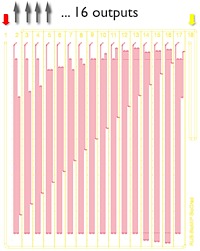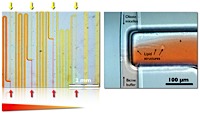In order to realize phase space screening for protocells, we have developed various hydrodynamically controlled gradient microfluidic systems.
The resulting chip devices achieve a linear temperature gradient (60°C > T < 5°C) across the microfluidic chip in one dimension and a tuneable (16 step) concentration gradient generated along the second spatial direction, as a result of hydrodynamic pressure drops from one T-junction to the next meander structures. The microreactor has just two inputs and 16 separate output meander channels and allows kinetic and equilibrium phase changes (including hysteresis) to be monitored, varying the overall flow rate.
Hydrodynamic studies showing the successful formation of concentration gradients on-chip. Furthermore first experiments were done to observe the self-assembly of fatty acid micelles into lamellar vesicles within the microfluidic gradient device, a solution of 0.8 mM oleate micelles (pH10) was mixed with bicine buffer (0.4M, pH 8.5) at a T-junction (lower figure, right image). We were able to observe the phase transition between micelles and lamellar structures both at the junction and along the meander.








